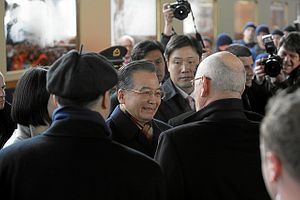Two political events late last year sent contradictory signals about the prospects for political reform in China. One was Premier Wen Jiabao’s comments about the desirability of political reform to help the Chinese Communist Party (CCP) retain power, which raised hopes that China’s fragile political situation might have forced the country’s leaders to seriously consider the possibility of genuine political reform.
The other event was the visit to Chongqing by Xi Jinping, the heir-apparent to President Hu Jintao, to praise popular Chongqing party boss Bo Xilai’s crusade of resurrecting socialist values and Maoist revolutionary culture. This visit, and the silence of other leaders in response to Wen’s comments on reform, suggests that the Chinese political leadership sees a return to Mao’s legacies, not democratization, as a solution to current problems.
But whatever the signals from China’s leadership, one thing is certain—the country has been facing increasing unrest over rising income inequality, growing regional disparities and official corruption. China is entering a period of deepening social tension, and it now faces having to cope with one crisis after another.
As a result, the Chinese leadership is finding it increasingly difficult not only to maintain the status quo, but also to manage popular discontent through quick pain relief measures such as coercion and economic growth. The reality is that as basic needs have been met through economic growth, Chinese have expressed greater demands for social justice and the protection of their rights from corrupt state capitalism and the growing inequality it has helped foster.
Yet while Wen and Bo proposed different long-term solutions to China’s challenges, they both share the goal of maintaining CCP rule. With this in mind, it’s hard to be optimistic about the prospects for the current leadership shifting toward democratization any time soon.
It’s true the leadership has carried out some political reforms since the 1980s, due largely to the increasing difficulties the regime was experiencing in sustaining the growing disconnect between a market economy and dynamic society and an anachronistic and authoritarian state. But the changes have been more administrative than political. And, while the CCP has gradually increased public participation at the margins of the political system, such changes have been aimed squarely at upholding CCP rule by increasing intra-party democracy, institutionalizing leadership politics and making the single party system more efficient and providing it with a legal base. After all, the stated objective of these political reforms has been to maintain social order and achieve social harmony.
Looking ahead, there are three possible paths to political change that China could take. The first path would involve adopting Western-style competitive elections and transforming the CCP into a social democratic party to compete in electoral politics. The second path would mean embracing democratic ideals through the so-called shock therapy of rapid change, including overthrowing the CCP.
China’s leaders believe the country isn’t ready for the first path, and it sees the second as creating an unacceptable risk of turmoil. They argue, sincerely in many cases, that China’s different political history and culture require a third way that retains single party rule and gradually expands political participation to allow China to evolve in a unified and peaceful manner.
But as it strives for this third path, the Chinese leadership isn’t ready to put up with the distractions of a vocal opposition party—or see itself submitted to regular electoral scrutiny. With opponents liable to be jailed, and with even Internet dissent censored and blocked, the first two paths toward reform are fading into the distance.
Suisheng Zhao is professor and executive director of the Center for China-US Cooperation at the University of Denver, and founding editor of the Journal of Contemporary China.

































